Arizona
| |
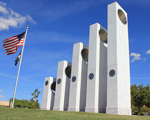 |
Anthem |
Arizona |
USA |
Sun Alignment |
Dial 821 |
| The Anthem Veterans Memorial in Anthem, AZ was dedicated on November 11, 2011 at 11am (11-11-11) to honor the service and sacrifice of the United States armed forces and to provide a place of honor and reflection for veterans, their family and friends. Veterans gather here annually on November 11th to watch a solar alignment at 11:11am when the sun precisely illuminates a 3-foot medallion of The Great Seal of the United States. |
| |
| |
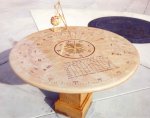 |
Bullhead City |
Arizona |
USA |
Horizontal Dial |
Dial 458 |
| This horizontal dial is an engraved flagstone approximately 42 inches in diameter designed by John Carmichael. The monofilar gnomon is a stranded brass cable that extends upward to a height of 18 inches and is held taught by a rock counterweight. Hour lines and direction of sunrise and sunset for the equinoxes and solstices are given. Also has noon Mark, The Equation of time, and a 32-point Compass Rosette |
| |
| |
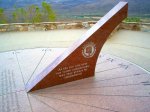 |
Bumble Bee |
Arizona |
USA |
Horizontal Dial |
Dial 389 |
| Horizontal dial approximately 10 feet in diameter. Made of concrete and granite. Commemorates Arizona Dept. of Transportation employees who were killed in the line of duty. |
| |
| |
 |
Carefree |
Arizona |
USA |
Horizontal Dial |
Dial 1 |
| A 90 ft. diameter horizontal dial with a large reflecting pool beneath the gnomon designed by architect Joe Wong and solar engineer John Yellott. The dial is constructed using a steel frame and covered in anodized copper. The hour markers are 4 ft. diameter concrete circles. The dial is designed to show solar time corrected for the time zone offset. Thus the hour markers have been moved ahead of the solar time position. The hour lines are separated by alternating dark and light colored stones. The gnomon itself is 4 ft. wide, 72 ft. long and the tip is 35 ft. high. A pilot dial at a scale of 1/4 in. =1ft. is at the South end of the large dial. It is constructed of gold-anodized aluminum with time lines at 10 minute intervals. An equation of time plaque is nearby. The upper surface of the dial formerly served as a solar water heater to provide hot water to the city's first office building. Numerals face outward, so that they are more easily read by viewers. |
| |
| |
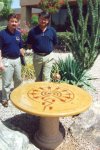 |
Casa Grande |
Arizona |
USA |
Horizontal Dial |
Dial 457 |
| This horizontal dial is an engraved flagstone approximately 40 inches in diameter designed by John Carmichael. The monofilar gnomon is a stranded brass cable that extends upward to a height of 15 inches and is held taught by a rock counterweight. The engraved stone shows time marks to 5 minutes, corrected for longitude. Time and direction of sunrise and sunset for the equinoxes and solstices are also given. |
| |
| |
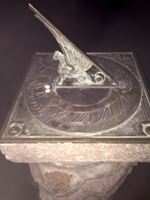 |
Flagstaff |
Arizona |
USA |
Horizontal Dial |
Dial 2 |
| Small bronze horizontal dial with a coarse chapter ring and Roman hour numerals. The gnomon is done as a gryphin. It was a gift from the observatory staff to Dr. Lowell. In a thank you note to his staff, Lowell stated, "Nothing could have pleased me more than that Sundial clothed with its mountain cloak, symbolic of when the sun always shines. It shall be inscribed with all your names and set up on the top of Mars Hill." The original square stone base is replaced by an irregular column of stone and concrete. The square plinth at top still supports the small horizontal dial. |
| |
| |
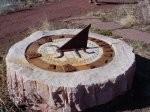 |
Flagstaff |
Arizona |
USA |
Horizontal Dial |
Dial 313 |
| This cast iron horizontal dial is set in a 6 foot diameter limestone base 2 feet off the ground. The interior region of the dial face is a white tile mosaic. The gnomon has pictures of buffalo and a horned lizard done in relief. The edge of the dial is a cast iron ring, upon which are four cardinal points and hour markers from 5am to 7pm, likewise in cast iron. The dial is corrected to mountain standard time. |
| |
| |
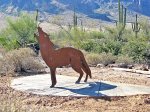 |
Gold Canyon |
Arizona |
USA |
Horizontal Dial |
Dial 657 |
| Built as an Eagle Scout project, this 10 x 5 foot semicircular concrete and steel dial features a 3 foot tall figure of a coyote as the gnomon. The tip of the coyote's nose functions as a point-in-space gnomon. The figure is placed well forward, limiting the times and dates the nose-tip shadow will fall within the hour circle to about 9 am to 3 pm on dates near the summer solstice. |
| |
| |
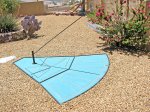 |
Lake Havasu City |
Arizona |
USA |
Horizontal Dial |
Dial 647 |
| An 8 x 9 foot horizontal dial of powder coat painted aluminum panels 1/4-inch thick assembled onto a concrete pad. Perimeter shows Arabic hour numerals 9-2 with 5-minute dots placed in arcs below the numerals. EOT correction is provided through four graphics on the dial face under the gnomon and sliding "T Square" indicators showing the corrections on rulers. EOT values are corrected for longitude. Dial face plates are supported on poured concrete pad.
Dial is on private property. Contact the owner to arrange viewing. |
| |
| |
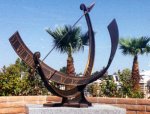 |
Mesa |
Arizona |
USA |
Equatorial Dial |
Dial 302 |
| Very handsome equatorial dial of bronze and dark marble, approximately 50 in (127cm). diameter. 6am to 6pm in Roman lettering. Gnomon in the form of an arrow. Sits on a triangular base atop a square marble top 21in (53cm) on a pedestal 39 in. (1m) high. |
| |
| |
 |
Mesa |
Arizona |
USA |
Analemmatic Dial |
Dial 801 |
| This concrete analemmatic dial is set is a larger concrete plaza located in a City park with an overall theme of Sonoran Desert environmental education and nature-based play. |
| |
| |
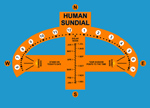 |
Oro Valley |
Arizona |
USA |
Analemmatic Dial |
Dial 871 |
| This analemmatic sundial is painted on concrete. It is similar to John Carmichael's human sundial at Flandrau Planetarium at the University of Arizona. The orange background was painted by hand with acrylic paint on top of the blue acrylic court surface. Lettering and other markings were painted with Rustoleum spray enamel using stencils from Stencilease.com. Final touch up painting was done by hand. It took a three man team ten days to paint. It's quarter hour time marks are longitude corrected and shows Standard Time when readings are adjusted using the Equation of Time. It includes a central Date Line for standing, using monthly and weekly marks. There is a Solar Noon mark, and Bailey Points to indicate the direction of sunrise and sunset. |
| |
| |
 |
Oro Valley |
Arizona |
USA |
Compound Dial |
Dial 713 |
| A massive, 24 foot [7.3m] tall combination almost-vertical and calendrical dial facing southwest so that northeast bound traffic can easily view the dial. The 13 foot [4m] diameter vertical ring dial of welded, zinc-coated steel declines 45 deg west and reclines 12 deg from vertical. The 3 inch [7.6cm] diameter, 20 foot [6m] long polar-pointing gnomon rod is supported in space by a 10 inch [25cm] diameter support tube with a cone nodus on the bottom end. The vertical dial shows longitude-corrected MST with hour and half-hour marks and Arabic numerals on the outer stainless steel chapter ring. |
| |
| |
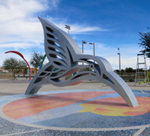 |
Peoria |
Arizona |
USA |
Horizontal Dial |
Dial 939 |
| This wonderful sculpture of a hummingbird serves as the gnomon for an 18 foot diameter horizontal sundial. The sundial sculpture was inspired by the beauty of the hummingbird with many species of them living and thriving in Arizona. The gnomon stands 7-feet tall with intricate aluminum frets welded together to give both depth and warmth to the hummingbird. Surrounding the gnomon are 150,000 Vetriluxe one-inch square glass mosaic tiles in bright colors depicting a flower where the bird sucks nectar. Inlaid into the tile work are Arabic hour numbers from 6am to 6pm as well as the cardinal points. |
| |
| |
 |
Phoenix |
Arizona |
USA |
Vertical Dial |
Dial 772 |
| A dual-vertical cube dial with two 12 inch square dial plates declining 45? south of east and south of west. The east face shows hour lines for 6 AM to 12 PM; the west face shows hour lines for 12 PM to 6 PM. Roman numerals mark three hour lines on each face. |
| |
| |
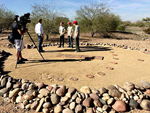 |
Phoenix |
Arizona |
USA |
Analemmatic Dial |
Dial 940 |
| On a trail of desert scrub is a cleared circular area, defined by a low pile of river stones as the border. Within is a titled analemmatic sundial about 30 feet across. The center walkway is made of sized adobe-red concrete tiles for each month. The abbreviation of each month is set into the tile. The matching hours on their elliptical arc are marked with small adobe-red concrete circles. |
| |
| |
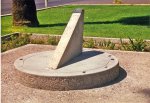 |
Phoenix |
Arizona |
USA |
Horizontal Dial |
Dial 7 |
| This large ground-level horizontal dial designed by Charles Keener. The dial is a circular concrete slab 62 in.(1.6m) in diameter and 8 in.(200cm) thick. The gnomon is 30 in. (762 cm) high, with the shadow casting style 55 in (1.4m) long. The dial has Roman numerals. Unfortunately, the 6AM and 8AM numerals are missing. The dial in a small square plaza surrounded by a row of bushes. |
| |
| |
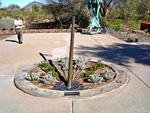 |
Phoenix |
Arizona |
USA |
Horizontal Dial |
Dial 578 |
| A 10 foot diameter horizontal dial with steel gnomon. Live desert plants fill planters delineated by hour lines. |
| |
| |
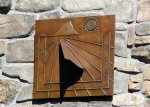 |
Prescott |
Arizona |
USA |
Vertical Dial |
Dial 585 |
| An 18x20 inch cast bronze vertical dial declining 22? west of south on the wall of a private home. Dial face includes a stylized sun and outline of Thumb Butte, a prominent local landmark. Dial can be viewed by first contacting the owner. |
| |
| |
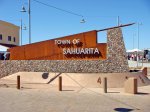 |
Sahuarita |
Arizona |
USA |
Obelisk or Vertical Gnomon |
Dial 623 |
| An unusual dial by John Carmichael using a gnomon tip to cast the shadow to indicate time. The dial face is poured concrete with inlaid metal longitude-corrected hour lines, and is nearly horizontal, inclining just 1.27 degrees for water drainage. It declines 89.28 degrees east of south. Bronze plaque has User Instructions and an Equation of Time Graph. Dial functions best during the middle part of the day. The style shadow lies outside of the dial face boundaries in the early mornings and late afternoons. The massive elaborate base that supports the gnomon rod is made from stacked flagstone. A waterfall cascades from the back south side of the base and flows a long distance to the south through a canal that has several water fountains and pools along the way. Around the base is a planter with bedding plants. The base and gnomon are lighted at night. |
| |
| |
 |
Sun City |
Arizona |
USA |
Horizontal Dial |
Dial 8 |
| A monumental horizontal dial in a gravel rock garden. Gnomon is 22 feet high, 40 feet long built from a structural steel "I" beam 64 feet long. Gnomon is supported by three concrete triangular legs and is encased in concrete with four shadow-casting style edges. A circular concrete walkway under the gnomon has painted Roman numeral hour markers. |
| |
| |
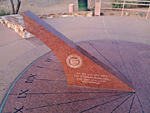 |
Sunset Point Rest Area |
Arizona |
USA |
Horizontal Dial |
Dial 1050 |
| Sitting on a low dais is a beautiful red granite sundial. The gnomon is about 1.5m high and 20cm wide sitting in the center of a dial about 2.5m in diameter. Hour lines radiate from the gnomon foot to the edge of the dais, marking the hours from VI (AM) to VI (PM) local solar time. Inscriptions are on both the east and west side of the gnomon, a plaque and names of those who died serving the citizens of the State of Arizona. |
| |
| |
|
Superior |
Arizona |
USA |
Horizontal Dial |
Dial 105 |
| A small 8 in. bronze horizontal dial with raised Arabic numerals marking the hours. The dial is set on a massive cobble stone and mortar base suitable for sitting upon while watching the hours. |
| |
| |
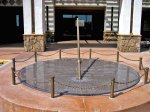 |
Surprise |
Arizona |
USA |
Horizontal Dial |
Dial 574 |
| A 108-inch diameter granite dial face with a 92-inch steel gnomon and nodus. Dial furniture includes a solar noon mark, sunrise and sunset points on the solstices and equinoxes, ecliptic date lines and an EOT graph. |
| |
| |
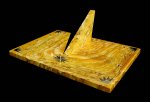 |
Tempe |
Arizona |
USA |
Horizontal Dial |
Dial 23 |
| A horizontal dial from Picture Rock Sandstone with 24k gold-plated inlaid brass fittings, 25 inches wide by 36 inches long, with gnomon 12.5 inches high. Gnomon is 1.5 inches thick. Total sundial weight 110 lbs. |
| |
| |
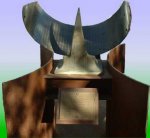 |
Tempe |
Arizona |
USA |
Equatorial Dial |
Dial 75 |
| An equatorial dial designed by R. Newton Mayall with a "curved triangular gnomon over a curved face approximately 12-in (.3m). wide. Tells the day of the year and standard time noon." Has a plaque explaining the Equation of Time. |
| |
| |
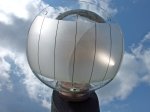 |
Tucson |
Arizona |
USA |
Globe or Hemispheric |
Dial 735 |
| A fused silica glass spherical lens projects a solar image spot onto the inner surface of a spherical segment of glass with a frosted area inscribed with hour lines and Arabic hour numerals. Time is read from the bright spot of light on the frosted surface while standing under the dial. Dial is mounted atop a pipe pillar on the patio of the Visitor Center. |
| |
| |
 |
Tucson |
Arizona |
USA |
Equatorial Dial |
Dial 4 |
| A bronze equatorial dial approximately 2 ft. in diameter designed by R. Newton Mayall. Mayall stated, "When I was asked to design the sundial in front of the Museum at Kitt Peak I was more than pleased, for it gave me a chance to work a semblance of astronomy into it. The design reflects the great telescope nearby, with its base and fork type mounting, the dial itself being the "telescope"." |
| |
| |
 |
Tucson |
Arizona |
USA |
Sun Alignment |
Dial 1039 |
| The Vista Sun Wheel is 63 feet [19.2 m] outside diameter and 197 feet [60 m] in circumference. The Wheel is composed of 28 tons of broken limestone. The central cairn is 11 feet [3.4 m] in diameter and 3 feet [1 m] high. In the center is a post marked by a sandstone block about 30 inches [76 cm] tall. The floor of the Sun Wheel called for another 28 ton of crushed decomposed red granite about 3/4 inch [2 cm] thick. Stone spokes indicate the solstices and equinox. Other stones 30-40 inches [75-100 cm] are set to various alignments outside the ring. A post indicates the setting sun on Groundhog Day, indicating one of the cross quarter days. The layout was made by direct observation, watching the progress of the sun along the horizon to solar standstill then return. 18 months were required to observe, mark and verify positions then setting stone and making the ring. The layout is similar to the Bighorn Wheel in Wyoming. |
| |
| |
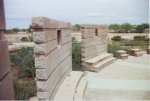 |
Tucson |
Arizona |
USA |
Sun Alignment |
Dial 11 |
| A "Stonehenge" or sun circle dial designed by Chris Tanz, Susan Holman, Paul Edwards and with the help of Will Grundy and sponsored by the Pima County Flood Control and Transportation Dept. The structure uses a broken circle of walls to create designs made of light based on the movement of the sun. The circle, 50 feet in diameter with 8 foot walls is modeled loosely on the Casa Rinconada kiva ruins in Chaco Canyon, N.M. The walls are of integrally colored concrete block, concrete, and flagstone. Lines on a bronze plaque indicate north and south and the direction of sunrise and sunset on the equinoxes and solstices. Holes in the wall do the same. Solar noon is marked when sunlight comes through a slot in the South wall and passes a line on the floor. |
| |
| |
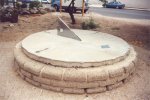 |
Tucson |
Arizona |
USA |
Horizontal Dial |
Dial 12 |
| This concrete and adobe brick horizontal dial is approximately 8 1/2 feet in diameter with a triangular gnomon 25 x 32 inches. This is a large, but very plain sundial except for the shiny chrome plated gnomon. It lacks numerals, but has hour points and shows the cardinal points. The dial is corrected for longitude. The pedestal is missing some bricks and is adorned with graffiti. |
| |
| |
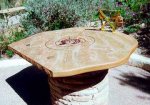 |
Tucson |
Arizona |
USA |
Horizontal Dial |
Dial 14 |
| A 25 inch circular engraved horizontal dial in a large irregular stone. Surrounding the dial on the stone are zodiacal signs and a beautiful engraved drawing of the surrounding mountains. The designer, John Carmichael, calls these dials "horizontal string heliochronometers" since the gnomon is a brass cable held very straight under tension from a heavy counterweight which is suspended from a brass hinged lever. |
| |
| |
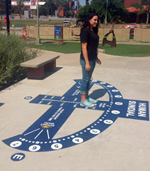 |
Tucson |
Arizona |
USA |
Analemmatic Dial |
Dial 825 |
| This nearly 14-foot wide analemmatic human sundial replaces the previous sundial at the same location. The previous dial by an unknown designer had several design errors and was in poor condition. The Flandrau Planetarium replace it, choosing a sundial with a blue background and white hour numerals. Dial Markings include quarter hour marks, Solar Noon Mark, Date Line with one week marks, Alignment Marker for Sunrise and Sunset (Bailey Points) with Solstice and Equinox lines, and the four Cardinal Points of the compass. The dial has a built-in longitude correction and shows Mountain Standard Time when readings are adjusted for The Equation of Time |
| |
| |
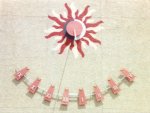 |
Tucson |
Arizona |
USA |
Vertical Dial |
Dial 456 |
| This is a 10 x 10 foot south vertical wall dial with hour lines painted on the wall that are corrected for longitude. A unique feature of this dial is the time scale can be rotated forward or back slightly to compensate for the Equation of Time. However, because only the hours are marked, precise minute reading is difficult. Welded steel was used to make the time marker ring and gnomon. |
| |
| |
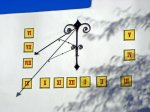 |
Tucson |
Arizona |
USA |
Vertical Dial |
Dial 711 |
| An 84x47 inch vertical dial declining 18? east of south on the outside wall of a private residence. Roman hour numerals are on 8 inch square hand-painted ceramic tiles. The gnomon and support are welded wrought iron painted black. A hand painted EOT graph is shown on a matching ceramic tile.
This is a historic home designed by southwestern architect Josias Joesler. Homeowner found original architectural drawings showing a gnomonically-flawed sundial that was never installed and contacted John Carmichael to design this accurate new dial. |
| |
| |
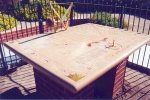 |
Tucson |
Arizona |
USA |
Horizontal Dial |
Dial 464 |
| A horizontal sundial 45 x 61 inches with a monofilar brass cable gnomon and tension counterweight. This is the largest horizontal sundial in the US carved on a single piece of stone, taking two years to build. The dial has hour lines from 5am to 8pm, corrected for longitude. Each hour line has an analemma and in the lower right of the dial is a graph of the Equation of Time. A nodus on the wire gnomon indicates date, with declension lines for summer and winter solstice, equinox, and date lines. Time and direction of sunrise and sunset are marked on the equinox and solstice lines. At the base of the gnomon is a 16-point compass rose. On the left side of the dial is a table for telling time by moon shadows. In the center is a copy of the hands from "The Creation" by Michelangelo. |
| |
| |
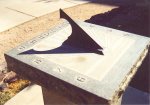 |
Tucson |
Arizona |
USA |
Horizontal Dial |
Dial 465 |
| A simple square horizontal dial 20 x 20 inches carved in a 3 inch block of granite with a bronze gnomon. The dial has hour lines from 6am to 6pm for local solar time. No graph or table for longitude and Equation of Time corrections. Dial sits atop a 3 foot square pedestal. |
| |
| |
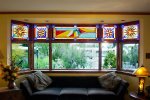 |
Tucson |
Arizona |
USA |
Vertical Dial |
Dial 533 |
| A declining vertical stained glass "Gecko" sundial 58 x 20 inches consisting of 153 colored glass pieces and exterior rod gnomon with triangular base. Paintings on 11 glass pieces use vitreous kiln-fired enamels and stains. Dial and four adjacent panels consisting of 540 glass pieces are set in bay window overlooking succulent garden containing additional sundials. Dial glass panel includes painting of a Tucson Banded Gecko stalking fly, a star field, sun face and solar noon mark. Dial declines 27.4? east of south. Contact owner John Carmichael to arrange viewing. |
| |
| |
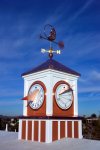 |
Tucson |
Arizona |
USA |
Vertical Dial |
Dial 544 |
| Four vertical dials on the faces of a 100-inch tall redwood cupola on the roof of a private residence. The 21-inch dial faces are kiln-fired porcelain on steel; the bezels and gnomons are copper. The dials are longitude corrected for MST. Three dials have solar noon marks. |
| |
| |
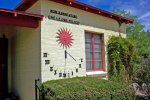 |
Tucson |
Arizona |
USA |
Vertical Dial |
Dial 579 |
| Located on a side street wall of a private home, this 4x6 foot due south vertical dial uses welded iron numerals and gnomon. Built in 1954, this is the oldest known sundial in Tucson. Designed using Mayall and Mayall's "Sundials" and described in detail in April, 1954 Home and Garden Magazine. |
| |
| |
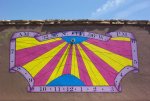 |
Tucson |
Arizona |
USA |
Vertical Dial |
Dial 566 |
| A vertical 44x92 inch dial declining 4.53? east of south painted on the rough textured stucco wall of a private home. The 2x4 inch tall conical horizontal gnomon is gold plated brass. The dial face is hand painted with elastomeric acrylic exterior house paint. The horizontal conical gnomon optimizes the nodus shadow at the location low latitude to show time and date. Dial face shows date/declination lines, solar noon mark and hour, 1/2-hour and 15 minute lines. To arrange viewing, contact owner Christina McVie. |
| |
| |
 |
Vail |
Arizona |
USA |
Analemmatic Dial |
Dial 599 |
| A brass and concrete analemmatic dial set in the Butterfly Garden at Colossal Cave Mountain Park at 3415 feet elevation. The dial is 21 feet E-W across the hour markers. A hand-held rod gnomon 143 inches long includes a bubble level for positioning. There is a modest park use fee to view this dial. |
| |